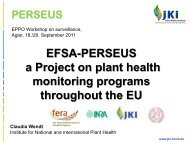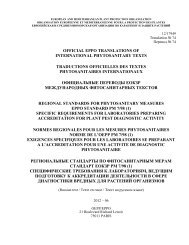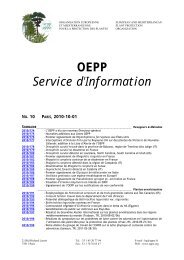Normes OEPP EPPO Standards - Lists of EPPO Standards ...
Normes OEPP EPPO Standards - Lists of EPPO Standards ...
Normes OEPP EPPO Standards - Lists of EPPO Standards ...
Create successful ePaper yourself
Turn your PDF publications into a flip-book with our unique Google optimized e-Paper software.
248 Diagnostic protocols for regulated pests<br />
water. The wells are formed using a 40-tooth comb (giving wells <strong>of</strong><br />
4 × 4 × 0.25 mm).<br />
Gel electrophoresis<br />
Electrophoresis is performed using the horizontal Multiphor II system<br />
(Amersham Pharmacia Biotech), in combination with a power supply<br />
(capable <strong>of</strong> delivering up to 400 V) and a circulating chiller-heater<br />
unit (e.g. Amersham Pharmacia Biotech MultiTemp III).<br />
Once the gel has been prepared, it is placed onto the ceramic plate<br />
<strong>of</strong> the Multiphor unit, which has been precoated with a thin layer <strong>of</strong><br />
melting-point bath oil (Sigma, Cat. No. M-6884) and aligned so that<br />
the leading edge <strong>of</strong> the wells is at position 4. Paper wicks<br />
(250 × 50 mm × 1.2 mm thick; Schleicher & Schull, GB004), which<br />
have been soaked in 1.67 × TBE, are then arranged to overlay the gel<br />
edges by 10–15 mm. The samples (5 µL) are then loaded into the<br />
wells. At least one positive control and one negative control is included.<br />
A glass plate (125 × 260 × 3 mm) is then placed on the inner edges <strong>of</strong><br />
the wicks, thereby covering the whole surface <strong>of</strong> the gel. The apparatus<br />
cover is then replaced, so that the electrodes make contact about 5 mm<br />
in from the outer edge <strong>of</strong> the wicks.<br />
The first run is performed under native conditions at 15 °C and a<br />
constant current <strong>of</strong> 20 mA. After about 6 min, the current is increased<br />
to 30 mA and the run continued for approximately another 55 min, by<br />
which time the dye marker has reached marker 8 on the ceramic plate.<br />
At this point, the valve controlling the flow from the water bath to the<br />
ceramic plate is closed, and the temperature <strong>of</strong> the water bath is then<br />
adjusted to 75 °C. While this heats, the run is continued for another<br />
15 min, or until the dye front is between positions 10 and 11 and the<br />
water temperature <strong>of</strong> the disconnected water bath has reached 75 °C.<br />
Prior to the return run (under denaturing conditions), the paper wicks<br />
are replaced with fresh ones and the gel and wicks covered by two<br />
polyester sheets, to prevent dehydration. The first sheet (95 × 270 mm)<br />
is placed between the paper wicks (covering the gel) and the second<br />
(175 × 270 mm) covers both the gel and the wicks. The glass plate and<br />
electrodes are then replaced and the valve carefully opened to achieve<br />
a gradual heating <strong>of</strong> the gel. The temperature <strong>of</strong> the water bath is then<br />
reduced to 60 °C, the polarity reversed and the return run started;<br />
initially at a constant 2 mA for 8 min, before increasing the current<br />
to 50 mA and running for 25–30 min, by which time the loading dye<br />
marker should have reached the left-hand wick. The gel is then removed<br />
from the ceramic plate and carefully rinsed in 96% ethanol to remove<br />
any residual oil, before rinsing in distilled water.<br />
Silver staining<br />
After electrophoresis is finished, the gel is fixed for 10 min in 10%<br />
ethanol containing 0.5% acetic acid (made up in distilled water). Fixing<br />
and all subsequent stages are done at room temperature with gentle<br />
shaking. The gel is transferred into 10 mm silver nitrate for 20 min,<br />
before washing twice in distilled water (1 min each). The gel is then<br />
transferred into a solution <strong>of</strong> 375 mm sodium hydroxide containing<br />
2.3 mm sodium borohydride and 0.4% formaldehyde (37% w/v) and<br />
left for 3–5 min, to allow the stain to develop, before stopping for<br />
10 min in 1% acetic acid. In positive samples, the viroid band should<br />
appear as a distinct band, separated from the other nucleic acids. To<br />
store gels, incubate in 10% acetic acid and 5% glycerol for at least<br />
(fraîchement préparée) de persulfate d’ammonium à 10%, et de l’eau<br />
distillée en quantité suffisante pour porter le volume total à 30 mL. Les<br />
puits sont formés à l’aide d’un peigne à 40 dents (donnant des puits de<br />
4 × 4 × 0,25 mm).<br />
Electrophorèse sur gel<br />
L’électrophorèse est réalisée à l’aide du système horizontal Multiphor<br />
II (Amersham Pharmacia Biotech), en combinaison avec un générateur<br />
(capable de délivrer jusqu’à 400 V) et un bain thermostaté (par ex.<br />
Amersham Pharmacia Biotech MultiTemp III).<br />
Une fois le gel préparé, il est placé sur la plaque en céramique de<br />
l’unité Multiphor, préalablement enduite d’une fine couche d’huile de<br />
bain au point de fusion (Sigma, Cat. No. M-6884). Il est aligné de sorte<br />
que les puits se trouvent en face du repère 4. Des mèches de papier<br />
(250 × 50 mm × 1,2 mm épaisseur; Schleicher & Schull, GB004),<br />
trempés dans du TBE × 1,67 sont alors disposées de manière à dépasser<br />
de 10–15 mm des bords du gel. Les échantillons (5 µL) sont alors<br />
déposés dans les puits. Utiliser au moins un témoin positif et un témoin<br />
négatif. Une plaque de verre (125 × 260 × 3 mm) est ensuite disposée<br />
à la bordure interne des mèches, recouvrant ainsi toute la surface du gel.<br />
L’appareil est refermé de manière à ce que les électrodes soient en<br />
contact à environ 5 mm de la bordure externe des mèches.<br />
La première migration a lieu en conditions natives à 15 °C et sous un<br />
courant constant de 20 mA. Après environ 6 min, le courant est porté à<br />
30 mA et l’électrophorèse se poursuit pendant environ 55 min, au bout<br />
desquelles le colorant marqueur a atteint le repère 8 de la plaque de<br />
céramique. La vanne contrôlant le flux entre le bain thermostaté et la<br />
plaque de céramique est alors fermée et la température du bain est<br />
ajustée à 75 °C. Pendant ce temps, la migration continue pendant<br />
15 min supplémentaires, ou jusqu’à ce que à la fois le front de migration<br />
du colorant se situe entre les positions 10 et 11, et que la température<br />
du bain ait atteint 75 °C.<br />
Avant l’électrophorèse retour (en conditions dénaturantes), les<br />
mèches de papier sont remplacées par de nouvelles, et l’ensemble gel<br />
et bandes est recouvert de deux feuilles de polyester afin d’empêcher la<br />
déshydratation. La première feuille (95 × 270 mm) est placée entre les<br />
mèches (et couvre le gel) et la seconde (175 × 270 mm) couvre à la fois<br />
le gel et les mèches. La plaque de verre et les électrodes sont alors<br />
remises en place et la vanne rouverte avec précautions pour obtenir un<br />
réchauffement progressif du gel. La température du bain thermostaté<br />
est ensuite réduite à 60 °C, la polarité inversée et la migration inverse<br />
commence; le courant initial est constant à 2 mA pendant 8 min, puis<br />
augmenté à 50 mA; la migration dure pendant 25–30 min, pendant<br />
lesquelles le colorant marqueur doit avoir atteint la bande de gauche. Le<br />
gel est ensuite enlevé de la plaque de céramique et soigneusement rincé<br />
d’abord dans de l’éthanol 96% pour éliminer l’huile résiduelle, puis<br />
dans de l’eau distillée.<br />
Coloration à l’argent<br />
Après l’électrophorèse, le gel est fixé pendant 10 min dans de l’éthanol<br />
à 10% (dans de l’eau distillée) contenant 0,5% d’acide acétique. La<br />
fixation et toutes les étapes suivantes sont réalisées à température<br />
ambiante sous agitation lente. Le gel est transféré dans du nitrate<br />
d’argent 10 mm pendant 20 min, avant de subir deux lavages à l’eau<br />
distillée (1 min chaque fois). Il est ensuite transféré d’abord pendant 3<br />
à 5 min dans une solution d’hydroxyde de sodium 375 mm contenant<br />
du borohydride 2,3 mm et 0,4% de formaldéhyde (à partir d’une<br />
solution à 37% p/v) pour permettre le développement de la coloration,<br />
puis pendant 10 min dans de l’acide acétique 1% pour stopper la<br />
réaction. Dans les échantillons positifs, la bande du viroïde est une<br />
© 2002 <strong>OEPP</strong>/<strong>EPPO</strong>, Bulletin <strong>OEPP</strong>/<strong>EPPO</strong> Bulletin 32, 245–253

















